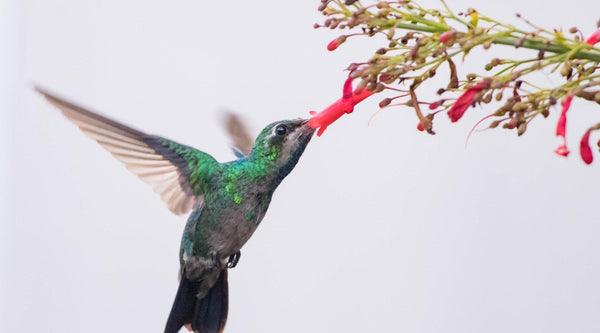How to Create the Ultimate Hummingbird Sanctuary
What can be more rewarding than creating the ultimate hummingbird sanctuary in your very own backyard!
Imagine yourself sitting on a cool fall evening, enjoying the peaceful company of your feathered friends buzzing about your yard. From the wildflower garden to the feeder, the swing then back to a tree with maybe a dive bomb mixed in between.
There's plenty of staples you can add to your backyard to create the ultimate hummer haven. This post is about all those building blocks and then some which all build on one preface:
If You Build A Sanctuary... They Will Come
Really, the fundamentals for a Hummingbird Sanctuary come down to supporting the basics of Maslow's Hierarchy of Needs:
Physiological & Safety
Hummingbirds require the physiological support of food, water, shelter and safety - in the emotional assurance that those basic needs will continue to be met and can be protected (think swings).
Food
For the ultimate sanctuary experience, provide hummingbirds their best serving of native wildflowers with a variety of nectar producing plants that support the local ecosystem in addition to a steady supply of fresh nectar.
Natural Food Sources
Provide a tall hedge of flowering plants behind a lower section of wildflowers that bloom at varying intervals throughout the year. This will provide year round feeding options with multiple locations to feed and retreat to the hedge as needed. Aim for a variety of brightly colored, tubular shaped flowers, varying in shapes and sizes for the ultimate hummingbird delight.
Supplemental Food Sources
In addition to natural food sources, provide a steady supply of fresh nectar feeders throughout your yard. This gives hummingbirds the baseline assurity that there is always a supply of fresh nectar on tap. Try making your own using our DIY Recipe or try Pop's Nectarade with added electrolytes and wildflower extracts. If you're making your own - there's no need for red dyes which can be harmful to a hummingbird's diet. Hummingbirds will be able to find your feeder without the need of any dyes thanks to their inquisitive nature.
Clean feeders and provide fresh nectar often - this can mean changing your feeders every 1-2 days when its especially hot out.
Pro Tip: Try filling your hummingbird feeders to the level of your hummingbird's feeding activity every 1-2 days to ensure you have the freshest nectar on the block. (All the cool kids will know about it)
Provide multiple feeders at varying locations throughout the yard, always in well protected areas out of direct sunlight and shaded when possible. If you have a hangry hummingbird bully that fights off other hummingbirds, try adding feeders at opposite ends of the yard - out of direct sight from one another to encourage friendly sharing.
Be sure you keep nectar fresh and feeders filled with a reliable source of healthy nectar. Keeping the suppy steady and reliable is key as hummingbirds work off recall memory and will stay close to a reliable consistent source of food.
Healthy Insect Habitat
In addition to nectar, hummingbirds require a healthy diet of insects: flies, mosquitoes, gnatts and other insects contribute to a hummingbird's diet of protein and fat. Maintain your yard in ways that create a healthy habitat of insects. Try soap water with vinegar for pests like ants. If you have grass, try mowing less often to allow grass to grow tall and provide a local ecosystem for gnatts - which are a hummingbirds delight.
Water
Water is a staple for any sanctuary and needed to support all life. Add a continuous source of fresh water so your hummingbirds can thrive. If you have a large fountain consider adding stones to create smaller areas for water to gather and bubble over more subtly for tiny hummingbirds. Misters are a great addition as well in your hummingbird garden. Be sure to keep water sources fresh for plenty of drinking and bathing.
Shelter
Offer shelter to retreat from predators, rest and raise young. Who wouldn't want all that? Hummingbirds are constantly hours away from starving to death and of upmost priority they conserve energy when they arent flying around feeding. Consider a variety of bird houses, nesting boxes, mature trees, hedges. Awnings and eaves work great too!
Safety & Security
Give hummingbirds peace of mind in the safety that their food, water and shelter will continue to be provided in a healthy maintained habitiat and security that they can be protect and guard against infringers with a hummingbird swing (because hummingbirds are territorial you know).
Provide plenty of places to perch and defend their new homestead sanctuary because the pursuit of liberty and happiness is fundamental to the sanctuary experience.
Let Them Come And Don't Forget To Share:
We love to hear from you and see your sanctuaries and hear your stories of creating habitats for wildlife in your backyard. Share on social media or messenger @PopsBirding and les us know what's going on in your backyard.
Tips For A Happy Sanctuary
- Keep feeders clean and change out nectar often
- Avoid harmful dyes or additives in your nectar
- Add a variety of native wildflower sources of nectar and seed producing flowers if you’d like to invite some finches to your sanctuary ;)
- Maintain your yard in natural ways that encourage a healthy habitat and sources of insects
- Provide plenty of areas to shelter from predators, rest and raise young
- Provide a continuous source of fresh water to sustain all wildlife
- Offer multiple areas to feed and perch so a variety of hummingbirds can coexist
- Place feeders and swings in well protected and shaded areas in separate areas of the yard.


